'One World, One Promise'
Scouting's 100th Birthday
By Scott Daniels
Photographs by Randy Piland
Scouting's centennial marks a milestone in the history of the world's largest youth-serving organization.
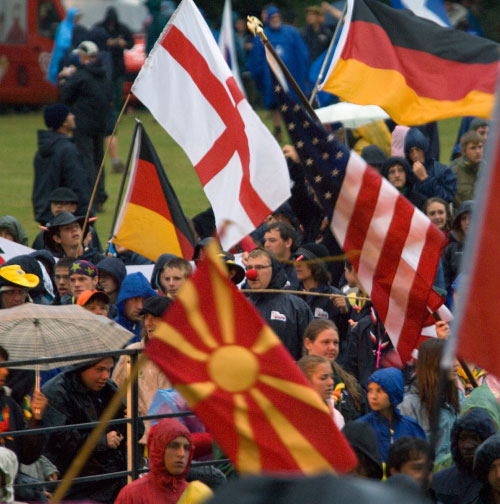 A mass of international flags representing more than 160 countries wave throughout the arena at the closing ceremonies of the 21st World Scout Jamboree in England. |
It all began on a small island.
In 1907, about 20 British lads from both privileged and working-class families camped on tiny Brownsea Island off the southern coast of England. Led by a famous, retired British general and several other gentlemen, the boys learned about chivalry, honor, woodcraft, nature, lifesaving, and sports. Robert Baden-Powell, the camp’s founder, called this experiment Scouting.
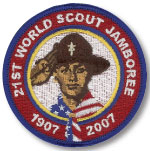 Who could have imagined that 100 years later, the program conceived by Baden-Powell to create a more tolerant and peaceful society, would have grown into a worldwide movement of 28 million Scouts in more than 160 countries?
Who could have imagined that 100 years later, the program conceived by Baden-Powell to create a more tolerant and peaceful society, would have grown into a worldwide movement of 28 million Scouts in more than 160 countries?
Early on Aug. 1, Eagle Scouts Nathan Watson of Troop 45, Murray, Ky., and Johnny Harkey of Troop 131, Carmel, Ind., stood on Brownsea Island to represent the BSA in celebrating Scouting’s centennial. At Hylands Park in Chelmsford, 30 miles northeast of London, 3,100 more BSA Scouts and leaders sat in an arena crowd of 35,000 for a sunrise birthday party at the 21st World Scout Jamboree.
At precisely 8 a.m., the United Kingdom’s Chief Scout, Peter Duncan, blew the same kudu horn Baden-Powell had used at his 1907 camp. Satellite dishes linked images from Brownsea and Hylands Park to the rest of the world as Scouts raised their right hand and repeated the Scout Promise. A polyglot recitation of the nearly identical creed of honor and duty gave true meaning to the jamboree’s theme, “One World, One Promise.”
A royal welcome
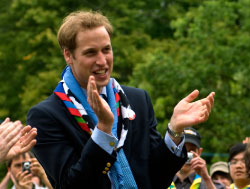 Prince William applauds a group of international Scouts performing on African drums. |
The jamboree began with a surprise visit from one of Britain’s most famous celebrities, Prince William, second in line to the British throne. Accompanying the prince was the Duke of Kent, president of the United Kingdom’s Scout Association.
Throngs of young people followed the prince on his “walk about,” which included several stops in the jamboree’s Global Development Village. The future king sat cross-legged on the floor of an exhibit tent and tasted some Moroccan coffee and later tried his hand at beating some traditional rhythms on an African drum
Prince William was just one of many international dignitaries to visit Scouts at the jamboree. Others included former president of Poland Lech Walesa, recipient of the Nobel Peace Prize; Jane Goodall, environmentalist and chimpanzee researcher; and the king of Sweden, Carl XVI Gustaf. The king is honorary president of the World Scout Foundation.
Out-of-this-world visitor
The prize for the VIP traveling the greatest distance to the jamboree went to astronaut Clayton Anderson, even if he did so via ham radio from the International Space Station. A select group of 10 Scouts, including the BSA’s Nick Jungman from San Diego Troop 406, each got to ask Anderson two questions about life in space.
Because the Scouts would have less than 10 minutes of radio contact as the space station’s orbit passed over England, they conducted a full Q & A rehearsal before the 10:10 p.m. flyover. Later, when radio contact was established, astronaut Anderson greeted the Scouts, and the audience cheered.
Nick Jungman got to ask the final question. Was Anderson ever a Boy Scout?
The astronaut, who earned his First Class Scout rank in Ashland, Neb., said, “Scouts helped me to learn a lot about myself and to take care of myself in a harsh environment -- like the woods or the space station.”
Service, mud, and history
VIPs and dignitaries were important, but it was the interaction among the jamboree’s 40,000 Scouts that created lasting memories of a once-in-a-lifetime experience.
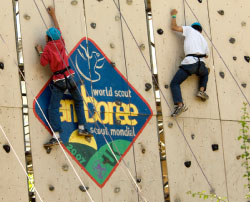 Scouts reach for handholds on Gilwell Park's climbing wall. |
Organizers scheduled seven activity modules for every Scout. Three of those took place off-site with 13,000 people boarding buses each day for a ride to and from their assigned event. Understandably, the logistics were enormous.
Many Scouts, though, said the off-site events were among their favorite activities of the jamboree.
The Starburst module, for instance, provided Scouts with service projects in nearby communities. Some cleared forest trails to improve visitor access and wildlife habitat. Others repaired and painted playground equipment at a school for special-needs children. Still others planted and maintained gardens at a hospital for the enjoyment of its patients.
At Gilwell Park, Scouts slogged their way across the high-energy Challenge Valley, a true test of stamina through a muddy obstacle course. There were also opportunities for wall climbing, rappelling, mountain biking, and archery. Many adults who revere Gilwell as the site of Baden-Powell’s first Wood Badge course took advantage of the Scouting history tour.
Aquatics meets pioneering
It was the Splash module, however, that received the most raves. Located at Alton Water Reservoir in Suffolk, Scouts had a choice of canoeing, sailing, kayaking, board sailing, or raft building.
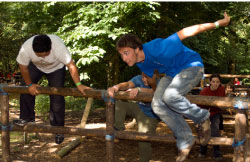 Scouts hurdle wooden beams at the rugged "Challenge Valley" obstacle course. |
“Kayaking was a lot of fun,” said Peter Husted of Seattle. “Even capsizing was fun. The water was great and warm.”
Austin Wolff of East Dubuque, Ill., paired up to go sailing and, despite his novice experience and some brisk winds, never tipped over. “We had a couple of close calls, though,” he admitted.
On the opposite side of the lake, the skull and crossbones flag flew as teams competed in raft building. Their materials? Four 50-gallon sealed drums, six wooden spars, and rope. The object was to lash the spars and drums together and then paddle out to a floating dock to retrieve a bucket of tennis balls. The first raft back to the shore won.
In reality, it was more fun to build the raft and then sink an opponent’s by … what else? Splashing them. Pirates definitely ruled the high seas of Alton Reservoir.
Down time and cultural exchange
Back at Hylands Park, there were plenty of activities to keep busy, but Scouts could adjust schedules to fit their energy level.
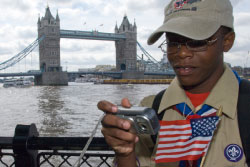 Atlanta Scout Joshua Tucker tours London before arriving at the world jamboree. |
Some enjoyed watching England challenge Australia in an impromptu game of cricket, complete with partisan cheerleaders. Yanks, however, were completely confused and had a hard time deciding whether the “sport of the British Empire” more closely resembled croquet or baseball.
Evenings afforded the best opportunities for cultural exchange. Each subcamp housed nearly 2,000 Scouts from as many as 20 countries. Dinner invitations from neighboring troops were common, and the meals often featured national cuisine. Thousands of Scouts exchanged e-mail addresses, traded patches, and swapped uniforms.
A brotherhood of Scouting
John Inman, Advisor of Venturing Crew 337 with teenagers from the BSA’s Central and Northeast Regions, is a veteran of five previous world jamborees.
“It’s always fun to watch the kids’ reactions when they meet kids from other nations and realize how much they have in common. They discover how small our world is.
“There are Scouts here from countries that have been at war with each other, and they get along fine. It’s through Scouting that a lot of these kids are going to grow up sharing the same values.”
And isn’t that what Baden-Powell had in mind all along?
Scott Daniels is the managing editor of Scouting magazine.
BSA's 2010 Scout JamboreeThe BSA will celebrate its 100th birthday at the 2010 National Scout Jamboree, July 26 through Aug. 4, 2010. The jamboree will be held at Fort A.P. Hill, in Caroline County Virginia, near Bowling Green. The site, in central Virginia, is close to historic Fredericksburg and 45 minutes southwest of Washington, D.C. “We’re going to have one heck of a party,” said Robert J. Mazzuca, the BSA’s Chief Scout Executive. “Not only will this gathering allow us to celebrate our glorious past, it will provide an equal Jamboree youth applications will be available online at www.Scouting.org/jamboree in spring 2008. Scouts, Varsity Scouts, and adult unit leaders will be selected and organized into local Scout council contingent units. Adults who want to serve on the jamboree staff will also find applications online. All jamboree participants must meet the eligibility requirements stated on the application. -- S.D. |
A World Scout Jamboree QuizQUESTIONS 1. Scouting began in the UK in 1907. What was the second country to adopt the Scouting program? (Hint: It wasn’t the United States.) 3. Where did the word jamboree come from? 4. In number of participants, what were the top five Scout associations attending the jamboree? 5. How much did a .33-liter can of Coca-Cola (not quite 12 ounces) cost from an on-site jamboree vending machines? 6. Only six countries have no Scouting programs. Can you name them? 7. The next world jamboree takes place in 2011. Where will it be? 8. What gigantic event took place at Hylands Park only 10 days after the jamboree ended? 9. What item in the jamboree souvenir catalog was the most expensive? 10. What are the two official languages of World Scouting? ANSWERS 1. Chile became the second country to adopt Scouting in 1909, one year before the United States. 2. A kudu horn is a musical instrument made from the twisted pronged horn of the African kudu antelope. Baden-Powell blew it at the beginning of the 1907 Brownsea Island encampment, and the same horn was blown by U.K. Chief Scout Peter Duncan 100 years later at the island’s August 1 sunrise ceremony. The kudu horn is also often used to signal the start of a Wood Badge training course or activity. 3. The word jamboree is thought to be derived from Swahili for hello, jambo. Speaking at the first world jamboree in 1920, Baden-Powell said, “People give different meanings for this word, but from this year on, jamboree will take a specific meaning. It will be associated to the largest gathering of youth that ever took place.” 4. The United Kingdom (6,104), Boy Scouts of America (3,125), Italy (2,166), Japan (1,483), and Portugal (1,425). 5. A .33-liter can of Coca-Cola (11.15 ounces) from a jamboree vending machine cost 1 British pound or $2.04. 6. The six countries without Scouting are: Andorra, Myanmar (Burma), Cuba, People’s Republic of China, Democratic People’s Republic of Korea (North Korea), and the People’s Democratic Republic of Laos. 7. Sweden will host the 22nd World Scout Jamboree in 2011. 8. The annual two-day V-Festival rock concert, sponsored by Richard Branson’s Virgin Group, was staged at the same Hylands Park arena used during the world jamboree. This year’s headline acts -- Foo Fighters, Damien Rice, Iggy Pop and the Stooges, and The Fray -- entertained more than 160,000 concertgoers. 9. Struck in 22 carat gold-proof quality, the Scouting Centenary 50-pence coin features the centennial dates, fleur-de-lis, and “Be Prepared” Scout motto. A limited edition of 1,250 coins from the Royal Mint was available at 345 pounds each (about $700). 10. The two official languages of World Scouting, used in arena show programs and in the official jamboree newspaper, are English and French. |
November - December 2007 Table of Contents
Copyright © 2007 by the Boy Scouts of America. All rights thereunder reserved; anything appearing in Scouting magazine or on its Web site may not be reprinted either wholly or in part without written permission. Because of freedom given authors, opinions may not reflect official concurrence.
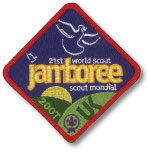 2. What is a kudu horn?
2. What is a kudu horn?